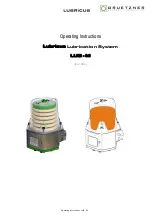
If you have completed flushing the pre filter & Post Filter (GT6-18LS) as mentioned above, you will only
need to run your filter system for about 30 – 60 minutes. You can then switch over to the DI filter by closing
the Drinking Water Valve & opening the DI resin filter valve. Allow this to continue flushing like this for 5
minutes. The system is then ready to use.
IV. Using the System
Once the filters have settled and it is ready for use, run the drain line into the sink/drain. Your Aquarium or
Drinking water tube will then run into a container or tank to fill with fresh filtered water. It is recommended to
keep the container you are filling in a water safe area – for example on the sink top in case of spillage (or
more commonly – if it overflows because you forget you turned it on) so you don’t come back to a flooded
room. A handy tip is to use a timer the first time you use the unit and note how long it takes to fill your
desired storage container.
It is recommended that you only use setting at a time – i.e. don’t run the drinking water and aquarium water
at the same time as this can cause channelling due to the low flow rate.
V. After Use & Storage
When the system is no longer in use, replace the blue plug back into the drinking water line to prevent
bacteria. The drain line can be left open as there is no chance of backflow or contamination on this line.
The system can then be stored away in a cabinet – if you have a plastic container or tub to put it in it is
ideal to prevent any water leaks.
VI. Long Periods of no use
If the system has been in storage for longer than a few days, it is best to run the unit for 15 minutes before
collecting the water. Bacterial contamination is not usually an issue with intermittent use but is possible
after over a month of storage. If there are any smells, tastes or changes to the water quality it is best to
replace the filter cartridges and start fresh to avoid any possible issues.
Maintenance
I. Sanitation
Due to the ‘open circuit’ nature of the portable systems, it is possible for bacterial contamination to occur
over time. Tubing may need to be sanitised or replaced along with the fittings.
The membrane housing (Which is one of the only parts that doesn’t get replaced) can be cleaned using
warm soapy water and then soaked in diluted HydroSil-ULTRA with water. Rinse off the excess HydroSil
and then re-connect.
II. Replacement Parts
As mentioned above, tubing and fittings should be periodically replaced to ensure the system remains
clean and functional. There is no set time frame for these items to be replaced, rather you can monitor
them ongoing and if they appear to be at their end of life, change them. As a general guideline, Tubing
(inlet, outlet and drain) should be replaced every 2 years. Fittings should be replaced every 3 years (due to
wear and tear).
III. Replacement Filters
As portable systems are made up from predominantly inline filter cartridges, when you replace the filters
you are getting almost a completely new ‘system’ as only the tubing and fi some other things
remain. Filters have a varying life time but generally can be replaced with the following principle; Pre filters
(Pre-Membrane) every 6 months. The Drinking Water Filter (GT6-18LS) should be changed every 2
months. As this is a DI filter system, you will need to monitor the TDS of both the membrane water & DI
filter ongoing to determine when it needs replacing. The membrane itself has a largely varying life time. It
may last anywhere between 1 and 4 years depending on usage, water quality and age.
IV. Testing Filters
Reverse Osmosis membranes have a variance in their filter life and this is affected by several things
including water quality, usage, temperature and filter maintenance. As they are the workhorse of the
system, they are the most important filters to monitor and keep maintained.




























